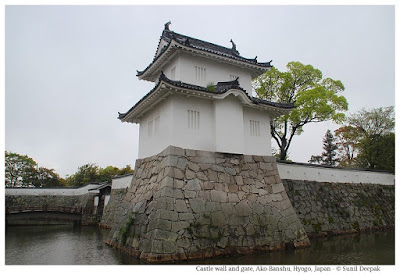Okayama and the fable of Momotaro
Okayama is one of the bigger cities in the south-west part of Japan. It is the city of the fable of Momotaro, the Peach-boy.
According to the fable, an old woman found a peach fruit. When she opened the peach, inside she found a baby boy, who told her that God had sent him to be their son. He was given the name of Momotaro (Momo = peach +Taro = elder son). When Momotaro grew up, together with his animal friends, a dog, a monkey and a pheasant, he went to fight Oni-demons. He killed the demons and came home with their treasures and lived happily ever after with his old parents.
Ekimae Market
Right across from the east exit of Okayama station is the Ekimae covered market. Full of shops and restaurents, along with an occasional hotel, I had great fun walking up and down this market. Most Japanese shops have boards and food-menu only in Japanese, so I loved trying to understand what different shops were selling.
I think that the area around the Nishigawa canal was part of old Okayama before the city was destroyed during the second World War. Rest of Okayama is a newly built city.
This round-shaped modern building was built in 1991. It is close to Shiroshita round-about on Momotaro Dori road. Designed by the well-known Japanese architect Yoshinobu Ashihara, the Okayama symphony hall is famous for its acoustics.
It has a lovely sculpture of a woman and a crane. The crane is a common motif in Okayama city. Its statues are there in the city and live cranes can be seen at the aviary in Korakuen park.
Crossing the Shiroshita round-about will bring you to the core cultural zone of Okayama. This area is marked by a number of parks along the two sides of Asahi river, along with a number of sculptures.
The black-coloured castle was built in the sixteenth century. It was also called U-Jo or the Crow castle. The old castle had the roof gilded in gold and was thus called the Gold-crow castle.
The present castle was built in 1966 as a concrete building. A few parts of the castle were gilded in 1996 when its 400th anniversary was celebrated. Outside, some remains of the old castle have been identified including the old walls and a pond. Parts of the old moat have also been recreated.
The three hundred years old Korakuen Gardens are counted among the most beautiful Japanese gardens. The aesthetic principles defining the beauty of the zen gardens in Japan include - Kanso (simplicity), Fukinsei (asymmetry), Shizen (naturalness), Yugen (subtletly), Datsuzoku (unusual), Seijaku (stillness) and Shibui (austerity). Trees with branches tending towards the ground are especially appreciated. These ideals are expressed in the Korakuen gardens in different ways.
Okayama Prefactural Museum is located near the main gate of Korakuen Gardens. A short walk from here will take you to a museum dedicated to an Okayama artist called Takehisa Yumeji. If you do not have the time to visit the Yumeji museum, you can admire some of his paintings which adorn the bridge leading to his house (in the image below).
Even if my stay in Okayama was short, I really liked this city. I stayed at Toyoko-inn near the Ekimae market and it was a perfect place to visit the city.
Among the different restaurents of Okayayama where I ate, I want to nominate Hajime at the Shiroshita round-about, where the people were really nice, the food and the ambiance (bookshelves full of Manga comics) were great.
I want to conclude this post with another sculpture from Okayama - this one is placed near the Western exit of JR Station. I want to apologise for not mentioning the artists of the different sculptures presented in this post. Their names were written exclusively in Japanese and I was unable to read them. However, if you can tell me the names of these artists in the comments below, I will be honoured to add them to this post.





















































